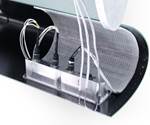Embraer, Collins Aerospace demonstrate CNT-based ice protection system
Electro-thermal heating system based on MEA technologies lowers energy requirements, adverse effects of ice and lightens weight, is undergoing flight testing on Embraer Phenom 300E jet.
Photo Credit: Embraer
A collaboration between (São Paulo, Brazil) and (Charlotte, N.C., U.S.) has culminated in the development and demonstration of a carbon nanotube (CNT) electro-thermal heating system that seeks to result in more efficient and sustainable aircraft. On July 20, the two companies began a flight test campaign in Gavião Peixoto, Brazil, for the advanced ice protection system.
Collins’ CNT heater and ice protection controller were successfully integrated on the vertical stabilizer and flight tested in Embraer’s fully functional Phenom 300E light jet prototype aircraft, executing more than 10 hours of ground and “dry air” flight tests. The successful first flight in Dec. 2021 demonstrated the seamless integration of the new technology, according to Embraer.
“We are encouraged by the recent test results, and we are convinced that this innovative technology will meet our ambitious technological and sustainability roadmap,” Luís Carlos Affonso, senior vice president, engineering, Technology Development and Corporate Strategy at Embraer, says. “We are glad to have Collins on this journey to explore further partnership opportunities that will help create a net zero carbon aviation industry.”
Heaters based on CNT technology are said to present significant advantages when compared to existing metallic heaters. Major benefits include eliminating the chemical etching process, lowering the energy requirement by 25% at system level and minimizing aerodynamic adverse effects caused by ice. The CNT’s heater element is also much lighter than a conventional metallic heater, features enhanced damage tolerance and should result in a longer product life cycle.
“This electrothermal CNT technology is more energy efficient, lighter and uses greener manufacturing processes than current systems, and we believe it will become the future standard for ice protection — including those in more electric aircraft designs,” Dr. Mauro Atalla, senior vice president of engineering and technology for Collins Aerospace, notes. “Collaborations such as the one between Collins and Embraer are helping innovations like this come to market more quickly.”
The evaluation of flight condition was possible after the conclusion of parameters evaluation, structural, electromagnetic compatibility and more than 500 hours in the icing tunnel, among other tests that have made steady progress in recent years. The technological and research activities aim to further increase the technology readiness level by conducting additional ground tests and flying in natural icing conditions.
The project is part of the More Electric Aircraft (MEA) technologies development approach, which includes a series of industry initiatives to ensure the commitment to net-zero emission by 2050.
Related Content
-
Welding is not bonding
Discussion of the issues in our understanding of thermoplastic composite welded structures and certification of the latest materials and welding technologies for future airframes.
-
Plant tour: Airbus, Illescas, Spain
Airbus’ Illescas facility, featuring highly automated composites processes for the A350 lower wing cover and one-piece Section 19 fuselage barrels, works toward production ramp-ups and next-generation aircraft.
-
Plant tour: Aernnova Composites, Toledo and Illescas, Spain
RTM and ATL/AFP high-rate production sites feature this composites and engineering leader’s continued push for excellence and innovation for future airframes.






